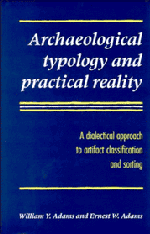 Archaeological Typology and Practical Reality
Archaeological Typology and Practical Reality Book contents
- Frontmatter
- Contents
- List of figures
- List of tables
- The archaeologist's preface
- The philosopher's preface
- PART I Introductory
- PART II The nature of types and typologies
- PART III Typology in action: the Medieval Nubian Pottery Typology
- PART IV Pragmatics of archaeological typology
- 13 The starting point: purpose
- 14 The determinants of types: variables and attributes
- 15 The making of types: formulation, designation and description
- 16 The use of types: typing and sorting
- 17 The ordering of types: taxonomy and seriation
- 18 Variation and variability in archaeological classifications
- 19 The bottom line: practicality
- 20 Principles of practical typology
- 21 Information-theoretic formulations
- PART V Classification, explanation, and theory
- Appendices
- References
- Index
17 - The ordering of types: taxonomy and seriation
Published online by Cambridge University Press: 23 November 2009
- Frontmatter
- Contents
- List of figures
- List of tables
- The archaeologist's preface
- The philosopher's preface
- PART I Introductory
- PART II The nature of types and typologies
- PART III Typology in action: the Medieval Nubian Pottery Typology
- PART IV Pragmatics of archaeological typology
- 13 The starting point: purpose
- 14 The determinants of types: variables and attributes
- 15 The making of types: formulation, designation and description
- 16 The use of types: typing and sorting
- 17 The ordering of types: taxonomy and seriation
- 18 Variation and variability in archaeological classifications
- 19 The bottom line: practicality
- 20 Principles of practical typology
- 21 Information-theoretic formulations
- PART V Classification, explanation, and theory
- Appendices
- References
- Index
Summary
We observed in the last chapter that the immediate reason for sorting entities is usually, though not always, to permit some kind of enumerative or statistical comparison between types. This in itself is an intermediate step toward the more fundamental goal of determining relationships between types. However, as we saw in Chapter 7, such relationships cannot be expressed within the structure of basic (one-level) typologies, because of the principles of equivalence of types and equidistance of types. In order to express relationships it is necessary to subject types to some kind of secondary ordering which is independent of the type concepts themselves (cf. Dunnell 1971b: 83).
The two most common procedures in secondary ordering are those of taxonomy and sedation. The former is a process of hierarchic clustering, and the latter of linear ordering. Both taxonomic ordering and seriation are common in archaeological classification, but we have delayed consideration of them until this point because, in the great majority of cases, they are incidental rather than essential features of the classificatory system.
Taxonomy
The term taxonomy, like other words relating to classification, has no generally accepted, precise definition. For many systematists, especially in the biological sciences, it is synonymous with classification itself (e.g. Mayr 1942: 3–17; Sokal and Sneath 1963; see also Brew 1946: 44–66). Our usage, however, is more restricted.
- Type
- Chapter
- Information
- Archaeological Typology and Practical RealityA Dialectical Approach to Artifact Classification and Sorting, pp. 202 - 213Publisher: Cambridge University PressPrint publication year: 1991


